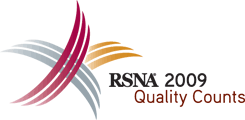
Abstract Archives of the RSNA, 2009
LL-PH4174-L03
Optimization of Pediatric CT Protocols by Cross-analysis of Absorbed Dose and Image Quality
Scientific Posters
Presented on December 2, 2009
Presented as part of LL-PH-L: Physics
Riccardo Ciolini, Presenter: Nothing to Disclose
Daniele Della Latta PhD, Abstract Co-Author: Nothing to Disclose
Angela Di Fulvio, Abstract Co-Author: Nothing to Disclose
Manuela Salvucci, Abstract Co-Author: Nothing to Disclose
Dante Chiappino MD, Abstract Co-Author: Nothing to Disclose
Francesco D'Errico, Abstract Co-Author: Nothing to Disclose
An intercomparison between different pediatric CT acquisition protocols was performed by cross-analyzing absorbed radiation dose and image quality.
Cylindrical phantoms were used to simulate the neonate morphology. The selected material was PMMA (density 1,19 g/cm3, close to the average tissue density of the head, i.e. 1,15 g/cm3). To simulate the head growth curves for children, 3 phantoms with diameters of 60, 100 and 160 mm, respectively, were used.
Images were acquired using a multidetector computed tomography (MDCT) scanner Aquilion 64 (Toshiba, Japan).
To evaluate the image quality (IQ) and the absorbed radiation dose, 37 different protocols were used, operating both in axial and helical mode. Only one parameter at a time was changed for comparing the different protocols (either current, or X-ray tube voltage, or slice thickness).
Computed Tomography Dose Index Weighted (CTDIw) was quantified using thermoluminescent dosemeters (TLD) placed inside the phantoms.
The image quality resulting from the various protocols was checked using a commercial phantom (CATPHAN module CTP401). An analysis was also performed by a selected group of radiologists called to express their opinion with respect to contrast, noise, spatial resolution and overall image quality.
Correlation between the results in terms of CTDIw and IQ was verified using linear regression.
By modifying the values of current (15-300 mA), voltage (80-135 kV), slice thickness (0.5-2.0 mm) and Field of View (FOV) (180-320 mm) the absorbed dose varied from 0.8 to 120 mGy. Axial scans showed doses higher than from acquisitions made in helical mode. According to the group of radiologist, the helical acquisition was better in terms of image quality. The best protocol was characterized by the following parameters: potential 120 kVp, slice thickness 0,5 mm, low dose modulation current, helical acquisition mode and FOV of 320 mm.
Obtaining good diagnostic images while reducing exposure risk requires the optimization of the acquiring protocols. Our study demonstrates that increasing the dose does not necessarily improve IQ (R2=0.654): some low-dose protocols showed better image quality than some commonly used higher dose protocols. Therefore their use should be encouraged, also for adult protocols.
Low Dose CT protocols reduce exposure risk of patients preserving good quality of diagnostic images.
Ciolini, R,
Della Latta, D,
Di Fulvio, A,
Salvucci, M,
Chiappino, D,
D'Errico, F,
Optimization of Pediatric CT Protocols by Cross-analysis of Absorbed Dose and Image Quality. Radiological Society of North America 2009 Scientific Assembly and Annual Meeting, November 29 - December 4, 2009 ,Chicago IL.
http://archive.rsna.org/2009/8007227.html

